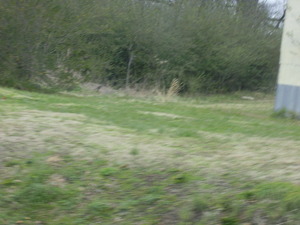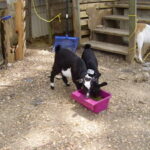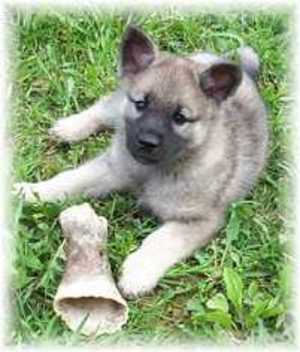Not so many years ago many farms had outdoor pastures for pigs. Confinement operations developed to raise large numbers of pigs in intensive conditions have been criticized by many; but raising pigs for the freezer is not difficult.
Small homestead production of pigs is not difficult nor is it expensive. It does take the right equipment and some important attention to non-negotiable issues. I’ve raised four Duroc gilts (females) in a 16X32 area. Some breeds, such as Large Blacks, Saddlebacks and Tamworths are less adapted to small areas and a larger fenced area suits them much better. Decide before getting ANY pigs and do some research as to which type you want. If you want to keep a few pigs to breed as well as producing meat for the freezer these rarer breeds can definitely use more people raising them and using them. If space is an issue you may be better getting the more popular breeds in a non-pasture situation. Simply buy “feeder pigs” – those pigs that are 30-40 pounds – and raise them to market size – 225-250 pounds.
If the closest you’ve ever been to a pig is the pork chop or sausage on your plate there are things about raising pigs you need to understand. Forget the often repeated statement that pigs stink. Properly housed and handled pigs don’t stink. The massive barns with 2,000 head do smell – so do proportionately sized places with 2,000 PEOPLE. Pig manure can be easily collected and composted – and given a choice pigs will have a designated “bathroom” area of their pen.
Those little cute pigs grow fast. Always keep in mind when handling larger pigs that despite what is often presented pigs are NOT vegetarians. They will eat chickens, lambs and small dogs that don’t get out of the pen fast enough. They can and have killed people and at one time when a work horse died it was hauled into the pig pen, a distasteful view of “recycling” but a fact on farms less than 100 years ago. Pigs are omnivores – they will eat whatever they find. If you bag unsprayed law grass it can be composted – or put in the hog pen. Leftovers, day old bread, several types of grain…several things can go into a pig’s trough. The amount of food needed is not as much as some might think if you use a protein supplement and corn, although corn is raising in cost at present and may not be a cost effective point depending on where you are. If you have dairy animals and an excess of milk that with grains can raise the pigs quickly and result in a great deal of pork in not a lot of space.
For the average small farm, small area place such as the pen mentioned above your best choices will be those such as the Duroc, Hampshire, Yorkshire or Spots. These breeds are common on many farms so easy to find. Typically they will have had the needle teeth clipped; and any boars will have been castrated. For what the typical homesteader is looking for – meat production, focus on barrows (castrated males) or gilts (females) rather than the boars. They’ll typically also have any vaccinations and worming needed to get the pigs off to a good start. Look for an animal that is healthy – longer bodied and lean. Eyes should be bright and eyes and nose should be free from discharges. Generally for home pork production avoid the “pot belly” pigs – they are too fatty and inefficient.
Have a proper pen for your pig(s) before bringing them home…and make the fencing *tight*. For the 16X32′ pen mentioned get six hog panels – these come in 16′ lengths and are about 3′ high – they’re welded steel and will cost about $18 each. You’ll also need a dozen steel T posts at about $3 each – drive these securely in the ground and wire the panels to the inside of the posts, which helps lend strength when larger pigs push against it. You’ll need a tank – secure so it can’t be tipped – for water. Very important is a shade or shelter. It is absolutely important to remember you MUST help pigs in the heat. They MUST have shade. A pig trapped in the sun in hot weather will die – they cannot sweat and have no way to cool themselves. A water area or mudhole is a small relief but they still need shade.
If you pasture pigs be sure to have solid fencing – your neighbors will not be happy with finding your pigs in their garden. Traditionally, as mentioned, corn has been the grain of choice but oats, barley and rye has been used as well as leftovers from buffet salad bars, garden excess. Chopped alfalfa is another means to give pigs roughage and add 16% protein to their diet. You can buy alfalfa cubes for about $10 for 50 pounds in many farm and feed stores. Measure about a pound of these and soak them in water so they break down into useful forage. With this and a pound of corn you’re on your way to some of the best pork you’ve ever eaten. A 225 pound pig will dress out at about 180 pounds of meat – and can be done over the course of a summer. It’s a way to use what is often overlooked – kitchen scraps of many kinds, yard “waste” and a little grain.
When you’re planning on raising a pig plan on two. Pigs are happier with a buddy. For the 5-6 months you’ll be raising them it is possible – and recommended – the pigs be treated humanely. The initial housing investment will last for several years and is at or under $200. Do not be tempted to tether them. Yes many have done it for years. But a tethered animal – be it pig, goat, sheep, calf, dog – whatever without a fence is prey for roaming dogs, coyotes and other predators. There is no excuse for not keeping your animals safe, fed and watered. Your initial purchase of pigs will vary depending on the area, season, etc but generally about $60-90 should find you a pair of pigs. Depending on what you’re feeding there are of course those costs. But for $300 plus feed in roughly six months you’ll have about 360 pounds of pork for the freezer…and remember that fencing outlay is still there for next year!
When the day approaches for killing and getting the pig ready for the freezer there are a few options depending on where you live. It can be done yourself or you can contact a small butcher to do it for you. There is usually a “kill fee” and a small fee for cutting. You choose if you want the hams smoked or fresh. How thick do you want the bacon and chops, how spicy do you want the sausage. Some people use the whole hog for sausage – if your family like sausage this might be something for the second pig – you’ll still get hams from the other. The day of killing keep water in front of the pigs but withhold food. If you’re hauling the pigs somewhere keep loading and hauling them low key – do not stress them. Stress affects the meat – and stress isn’t necessary. If you back the truck or trailer up to their pen and leave them no other place to go but in the vehicle they will go in. Under no circumstances should you hit or start chasing them. If they’re reluctant to load don’t fight them…simply take a bucket and put over their snout/face – most pigs will back up….”steer” them towards the vehicle and when you remove the buckets shut the door and they’re caught. There is an occasional pig who will try to charge through but MOST pigs will back up. After watching some people in frustration use abusive tactics in loading a couple of 600 pound sows I grabbed an empty garbage can – in 30 seconds the first was in the trailer. Seriously. No hitting, no chasing no swearing.
Many don’t realise how large pigs can get. The 225-250 pound market weight is not full grown. I’ve known some pigs – Yorkshire and a Tamworth – that weighed at or over 1100 pounds. Mature breeding animals are very strong and can kill a human if they wanted to. If you’re thinking of keeping animals to breed it’s important to know what you’re getting into and learn a little more about hog behavior. Some breeds of pasture pigs still carry the maternal instincts while others aren’t as much so. It’s important to remember pigs can and will eat anything smaller than them….and for some sows this can include her own pigs. Additionally with some pigs do not ever ever ever pig up a piglet without her securely on the other side of the fence. Pigs don’t normally jump but I’ve seen sows come up a good ways through the overhead door of old type hog houses and there are many who have lost fingers and more to a mama sow in blind defense of a baby pig. You really need to get some experience and be prepared when raising pigs. Each one is unique and many ARE good mothers and aren’t a danger to handlers – but sometimes you don’t know until you have that piglet screaming in your hands. Use caution.
Pigs can provide a freezer of meat in a relatively small area. They were once called the “mortgage lifter” for their ability to use food stuffs that would otherwise often go to waste – the pigs turned it into meat. They’re interesting animals and should be handled with caution and appreciation.






